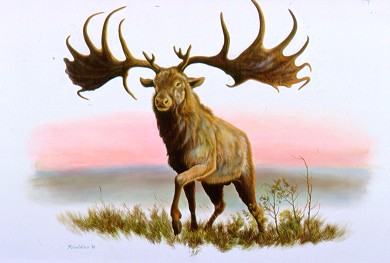 |
 |
 |
 |
 |
 |
 |
 |
 |
 |
 |
 |
 |
 |
 |
 |
 |
 |
 |
 |
 |
|
|
 |
|
|
|
Giant Irish Elk |
|
|
|
By Mark Walker |
|
|
|
The Giant Irish Elk was one of the largest deer species there has ever been. Its name is misleading, as it was probably a species of deer and not an Elk. It had a body height of about 2 metres and weighed over 700kg. It was roughly the same size as a modern day moose, but its antlers made it seem much larger. The Giant Elk was distributed across Europe from between 400,000 and 10,000 years ago. |
|
 |
|
|
|
|
|
The antlers were extremely large. They weigh between 35 and 40 kilograms. What is even more astonishing is the fact that they would be lost and regrown each year. This would mean the males would have to gain a lot of energy very quickly to allow them to grow at the required rate. The antlers probably evolved to be so big through a process called �runaway sexual selection�. Females would favour males with large antlers, so these males would be more likely to breed and pass on there big antler genes to their offspring. By selecting for ever larger antlers they would evolve to become bigger and bigger�����.
The Elk grazed mainly on grass. However to grow their massive antlers they would need high levels of minerals such as calcium and phosphorus. They would need to graze over extensive areas to gain enough energy and minerals. They would probably eat mineral rich plants such as willow. They would have needed to eat about 40 kilograms of flood per day to get the energy they needed for antler growth.
The antlers would have been grown only over a period of 4 months; they would need to be ready for use in the autumn when breeding occurred. It is unknown how the Elk bred, but it could have had a lek system, where males display to females, who then choose which males to mate with. The antlers were strong enough to be used for fighting between males, so maybe the males held contests to decide who got to breed. |
|
|
|
 |
|
|
|
The Elk became extinct about 10,000 years ago. This seems to have been due to climate change which led to the grasslands they relied on changing and disappearing. Man may also have played a part. At the end of the ice age humans were moving northwards and probably hunted elk which would have helped in their eventual demise. |
|
|
|
|
|
 |
|
|
|
Home |
|
|
|

